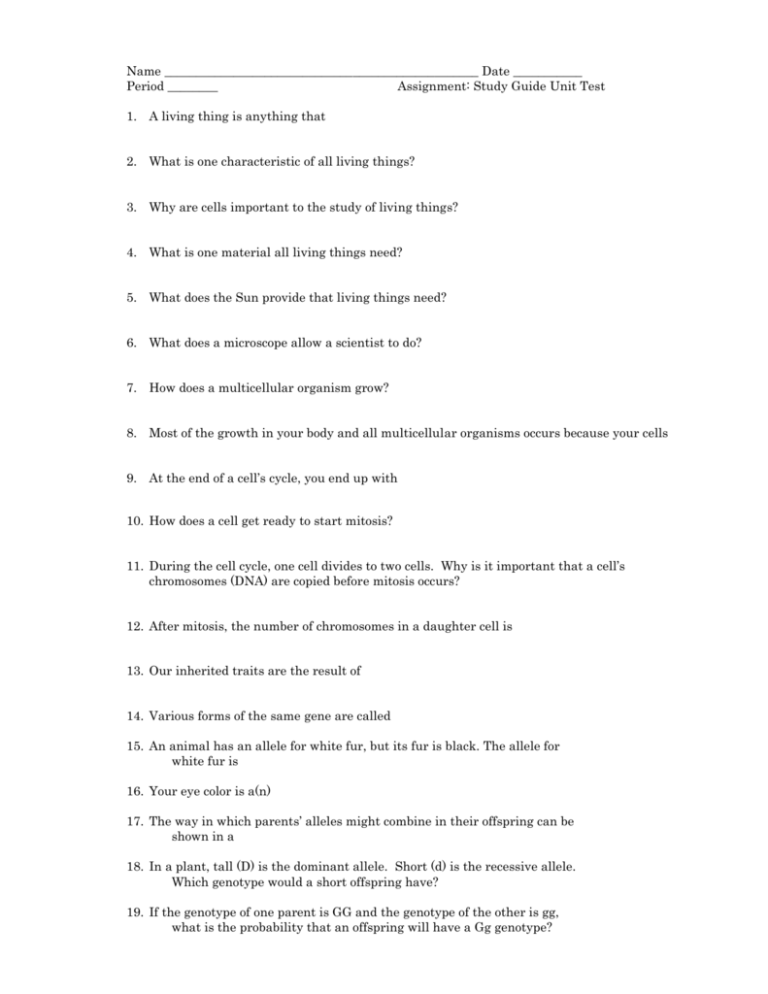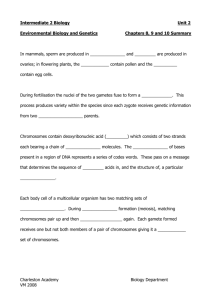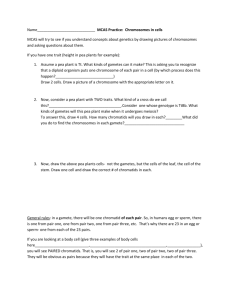Direction: The diagrams below show 5 parts of the cell cycle. Use
advertisement

Name __________________________________________________ Date ___________ Period ________ Assignment: Study Guide Unit Test 1. A living thing is anything that 2. What is one characteristic of all living things? 3. Why are cells important to the study of living things? 4. What is one material all living things need? 5. What does the Sun provide that living things need? 6. What does a microscope allow a scientist to do? 7. How does a multicellular organism grow? 8. Most of the growth in your body and all multicellular organisms occurs because your cells 9. At the end of a cell’s cycle, you end up with 10. How does a cell get ready to start mitosis? 11. During the cell cycle, one cell divides to two cells. Why is it important that a cell’s chromosomes (DNA) are copied before mitosis occurs? 12. After mitosis, the number of chromosomes in a daughter cell is 13. Our inherited traits are the result of 14. Various forms of the same gene are called 15. An animal has an allele for white fur, but its fur is black. The allele for white fur is 16. Your eye color is a(n) 17. The way in which parents’ alleles might combine in their offspring can be shown in a 18. In a plant, tall (D) is the dominant allele. Short (d) is the recessive allele. Which genotype would a short offspring have? 19. If the genotype of one parent is GG and the genotype of the other is gg, what is the probability that an offspring will have a Gg genotype? 20. What process takes place when a sperm combines with an egg? 21. A complete Punnett square shows 22. DNA is always copied before cell division during 23. How are sex cells different from other human cells? 24. What are homologous chromosomes? 25. An allele that is expressed even if only one copy is present in a genotype is a 26. Dwarf pea plants (tt) are crossed with with pea plants of regular height (TT). Which of these describes the first generation plants? 27. What are the chances that a human offspring will have an XY genotype? 28. A somatic (body) cell in humans has 46 chromosomes. How many chromosomes does a male gamete have? 29. How are traits passed from parents to offspring during sexual reproduction? 30. What happens during sexual reproduction? 31. Suppose that the allele for red flower color is dominant. A plant with red flowers is crossed with a plant with white flowers. What is one possible phenotype and one possible genotype of the offspring? 32. One parent has the alleles Rr for a gene. The other parent has the same alleles for that gene. What is the probability of the offspring’s being Rr? 33. Genes are found on 34. If there are 14 chromosomes in pea plant cells and pea plants reproduce by sexual reproduction, how many chromosomes are present in a gamete of a pea? BELOW is a diagram of a typical animal cell and plant cell. Read the clues and identify the parts of the cell or answer questions about the parts. 35. This part resembles City Hall because it controls all the activities in the cell. 36. This part resembles a power plant because it produces the cell’s energy. 37. This part controls the passage of materials in and out of the cell and resembles the City Limits. 38. Lysosome, vacuole, golgi body are all referred to as _______________. 39. This fluid allows for easy movement through the cell and resembles the road system in a city. 40. This organelle is not found in an animal cell and is responsible for photosynthesis in a plant cell. (Chlorophyl is found in this organelle) 41. The material contained in the nucleus that makes it the cell’s control center? (Not in pictures) 42. A scientist observes a single cell under a microscope. This cell was taken from a patient’s liver. She observes the cells and determines that they are dividing every 30 minutes. It takes 1 hour for the two divisions to take place. How many cells are present after three hours? 43. A scientist is observing a patient’s bone cells under a microscope. The scientist knows that the worst form of bone cancer grows rapidly and the cells divide every 5 minutes. The scientist does not know if the patient has bone cancer and is watching the rate that the cells are dividing. Here are the results the scientist recorded: 10:00 1 cell 10:20 4 cells 10.50 32 cells Show your work below and prove if the cells are bone cancer OR NOT. 44. Identifying Relationships Put the following in order of smallest to largest: chromosome, gene, and cell. 45. Below is a diagram of a human skin cell that is going through cell division. The diagrams of the parent cell and daughter cells are not complete. Complete the diagram below. Label the cell membranes, nuclear membranes, chromosomes (DNA). Identify how many chromosomes are in EACH nucleus. 1. 46. Below is a diagram of a human brain cell during different times in the cell cycle. Parts A, C and D are not complete and you must complete them. Use the hint given to you (in B) to help figure this out. Label the cell membranes, nuclear membranes, chromosomes (DNA). Identify how many chromosomes are in EACH nucleus. 47. Angela and Scott are new parents of a baby girl, Monica. Scott and Monica both have a dimple in their chins, but Angela does not. In humans, the gene for having a chin dimple is dominant (C), while the gene for not having a chin dimple is recessive (c). Part A What can you conclude about the genes for chin dimpling that Angela, Scott, and Monica have? Part B Use a Punnett square to demonstrate your answer for Part A. Direction: The diagrams below show 5 parts of the cell cycle. Use the diagram to answer the questions below. 48. Arrange the letters in the order that they take place during mitosis. 49. Draw what happens after stage D above? 50. We have 46 chromosomes. How many chromosomes does the organism above have in one of its’ cells? 51. Name each of the phases of the cell cycle in the diagram above. Here are the choices: interphase, prophase, metaphase, anaphase, telophase, cytokinesis A. ____________________________ B. _____________________________ C. _____________________________ D. _____________________________ E. _____________________________ 52. If you have the ability to roll your tongue into a tube-like shape, you are a "roller." Tongue rolling is determined by a dominant allele, R. If you cannot roll your tongue, you are homozygous recessive (rr). Clue: Your phenotype is “cannot roll tongue”. What is (are) your genotype? ________ Clue: Your mother’s phenotype is “cannot roll tongue”. What is her genotype? _____ Clue: You have siblings who “can roll” tongue. Use a punnett square to figure out what your father’s genotype must be. _______








